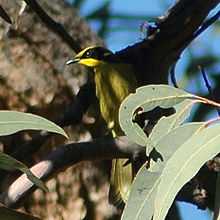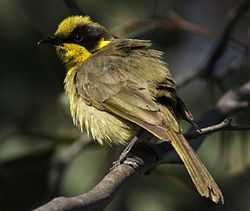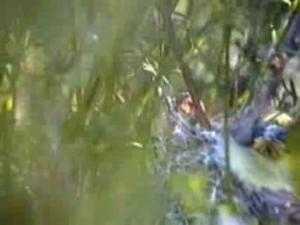Yellow-tufted honeyeater
| Yellow-tufted honeyeater | |
|---|---|
 | |
| Conservation status | |
| Scientific classification | |
| Kingdom: | Animalia |
| Phylum: | Chordata |
| Class: | Aves |
| Order: | Passeriformes |
| Family: | Meliphagidae |
| Genus: | Lichenostomus |
| Species: | L. melanops |
| Binomial name | |
| Lichenostomus melanops Latham, 1802 | |

The yellow-tufted honeyeater (Lichenostomus melanops) is a passerine bird found in the south-east ranges of Australia from south-east Queensland through eastern New South Wales and across Victoria into the tip of Southeastern South Australia. A predominantly black and yellow honeyeater, it is split into three subspecies.
Taxonomy
It was initially described by ornithologist John Latham in 1802 and given several names, initially Muscicapa auricomis and later Turdus melanops.[2] The latter name was retained as a nomen protectum and the former a nomen oblitum as the epithet melanops has been used consistently for over a century. It belongs to the honeyeater family Meliphagidae. More recently, DNA analysis has shown honeyeaters to be related to the Pardalotidae, and the Petroicidae (Australian robins) in a large corvid superfamily; some researchers considering all these families in a broadly defined Corvidae.
Subspecies
Four races are recognised:
- L. m. cassidix, helmeted honeyeater, restricted to a five km length of remnant bushland along two streams in the Yellingbo Nature Conservation Reserve, 50 km east of Melbourne in Victoria. It is the brightest and largest (weight 28 - 32 g) subspecies. In 2003 there were 103 individuals in the wild with 20 breeding pairs known as well as a further 34 birds in captivity at the Healesville Sanctuary.[3]
- L. m. gippslandicus, Gippsland yellow-tufted honeyeater
- L. m. melanops, Sydney yellow-tufted honeyeater
- L. m. meltoni, Inland yellow-tufted honeyeater, smaller and duller in plumage with a smaller tuft, described by G. M. Mathews in 1912.[4]
Description
It is 17–23 cm long, with females usually smaller, and has a bright yellow forehead, crown and throat, a black mask and a yellow ear and forehead tuft. The back is olive-green and underparts more olive-yellow.[5]
Distribution and habitat
The helmeted honeyeater subspecies is largely restricted to dense vegetation along riverbanks, dominated by the Mountain Swamp Gum (Eucalyptus camphora) with a dense understorey of sedges and tussock grasses.[6]

Status
Yellow-tufted honeyeaters, as a species, are not listed as threatened on the Australian Environment Protection and Biodiversity Conservation Act 1999 or on any state-based legislation. However, at the subspecies level, the helmeted honeyeater (L. m. cassidix) is considered to be a threatened species:
- This subspecies is listed as endangered on the Australian Environment Protection and Biodiversity Conservation Act 1999.
- This subspecies is listed as threatened on the Victorian Flora and Fauna Guarantee Act (1988).[7] Under this Act, an Action Statement for the recovery and future management of this species has been prepared.[8]
- On the 2007 advisory list of threatened vertebrate fauna in Victoria, the helmeted honeyeater is listed as critically endangered.[9]
Diet
Food includes lerps and other invertebrates, as well as nectar from eucalypts and other flowers.[3]
Reproduction
Breeding takes place between July and January, with one or two broods each season. The nest is a cup-shaped structure of dried grasses, bits of bark and other plant material usually in a fork of a tree 3–4 m (10–12 ft) above the ground. Two or three eggs are laid, pinkish in colour blotched with pale reddish- or buff-brown.[10]
References
- ↑ BirdLife International (2012). "Lichenostomus melanops". IUCN Red List of Threatened Species. Version 2013.2. International Union for Conservation of Nature. Retrieved 26 November 2013.
- ↑ Latham, J. (1802). Supplementum Indicis Ornithologici, sive Systematis Ornithologiae. London: G. Leigh, J. & S. Sotheby 74 pp.
- ↑ 3.0 3.1 Menkhorst P, Smales I, Quin B (2003). "Helmeted Honeyeater Recovery Plan 1999-2003". Australian Government, Department of the Environment and Water Resources. Retrieved 2007-06-21.
- ↑ Mathews, G.M. (1912). A Reference-List to the Birds of Australia. Novit. Zool. 18: 171-455 [408]
- ↑ Simpson K, Day N, Trusler P (1993). Field Guide to the Birds of Australia. Ringwood, Victoria: Viking O'Neil. p. 392. ISBN 0-670-90478-3.
- ↑ McMahon, A.R.G. and Franklin, D.C. 1993. The significance of Mountain Swamp Gum for Helmeted Honeyeater populations in the Yarra Valley. Victorian Naturalist 110: 230-237.
- ↑ Department of Sustainability and Environment, Victoria
- ↑ Department of Sustainability and Environment, Victoria
- ↑ Victorian Department of Sustainability and Environment (2007). Advisory List of Threatened Vertebrate Fauna in Victoria - 2007. East Melbourne, Victoria: Department of Sustainability and Environment. p. 15. ISBN 978-1-74208-039-0.
- ↑ Beruldsen, G (2003). Australian Birds: Their Nests and Eggs. Kenmore Hills, Qld: self. pp. 308–309. ISBN 0-646-42798-9.
External links
| Wikimedia Commons has media related to Lichenostomus melanops. |
| Wikispecies has information related to: Lichenostomus melanops |
